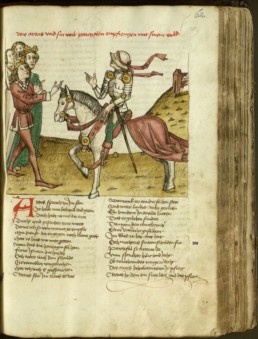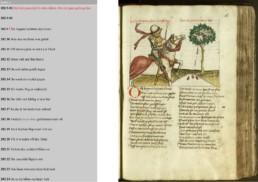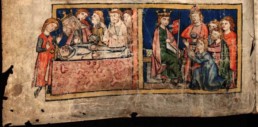The Coveted Knight
A project team from the University of Berne is working on a new edition of Wolfram von Eschenbach’s epic poem Parzival. The latest edition is almost two centuries old and no longer meets current requirements of textual criticism.
Anika Ruppen, translated by Sabrina Haslimeier | 01.01.2020
Handwriting Z Heidelberg, University Library, Cod. Pal. germ. 364 verse 1.1
Parzival mag der wohl berühmteste Ritterheld der mittelalterlichen Literatur sein. Der zwischen 1200 und 1210 verfasste Roman ist in so vielen Textzeugen erhalten wie kein anderer der Gattung der Artusromane: Laut den Angaben der Projektwebsite (www.parzival.unibe.ch) sind sechzehn Handschriften, ein Druck und 72 Fragmente bekannt, die den Text überliefern. Der jüngste Fund, ein in Mainz vorzufindendes Fragment, wurde im Jahr 2019 gemacht. Dass weitere vollständige Handschriften entdeckt werden, ist heutzutage eher unwahrscheinlich. Fragmente aber – also Bruchstücke von Handschriften – können jederzeit in den Einbänden von lange nicht mehr benutzten Handschriften entdeckt werden. Grund dafür ist die so genannte Makulatur: Primär um 1500 wurden Handschriften mit wertlos gewordenen Texten zerschnitten und das daraus gewonnene, nach wie vor wertvolle und sehr stabile Pergament wiederverwendet. Zumeist fanden Schnipsel und Streifen aus ehemaligen Handschriften ihren Weg auf Einbände von neuen Handschriften und Drucken, wo sie die entsprechenden Materialien verstärken sollten. So bleiben unter Umständen Teile von Textzeugen Jahrhunderte lang in Einbänden von vornehmlich in Bibliotheken gelagerten Handschriften versteckt. Teils zufällig, teils nach spezifischer Suche, werden sie schliesslich wieder aufgespürt.
Handwriting R Bern, Burgerbibliothek of Berne, Cod. AA91 61v verse 308.11
Masterpiece with shortcomings
Karl Lachmann’s edition of Parzival, which hasn’t been superseded to this day, was published in 1833, at a time when the study of vernacular poetry from the Middle Ages was experiencing a real boom. What was once considered a remarkable editorial achievement falls short of present day standards due to deficiencies — the methods used are outdated by today’s standards, even though it’s based on comparatively few manuscripts. Since the number of text witnesses has increased considerably since then, a majority of the manuscripts are not sufficiently taken into account.
“The cooperation with other disciplines such as computer sciences and evolutionary biology breathe new life into the subject.”
Future-oriented concept
In 2001, Prof. Dr. Michael Stolz (then at the University of Basel, since 2006 at the University of Bern) and his research team took on the challenge of preparing a critical re-write of the Parzival novel. In addition to a planned edition in printed book form, data will also be accessible in an electronic format. To establish a foundation, all 89 text witnesses were transcribed and the various groupings of manuscripts were investigated. “To the great advantage of the editors, Parzival’s textual history has already been explored several times and from different perspectives,” explains Dr. des. Mirjam Geissbühler, who has been part of the research team since 2011. At best, this would support our own investigations on previous research findings. However, innovative digital methods would enable cutting-edge possibilities in text editing and analysis. Thanks to electronic storage methods, new possibilities arise, including fresh perspectives on the connections between the different manuscripts.
Handwriting R Bern, Burgerbibliothek of Berne, Cod. AA91 55v verse 282.9
Ensuring accuracy
The project, funded by the Swiss National Science Foundation, has been met with widespread interest. “The digital database resulting from the Parzival project is a real treasure trove for researchers,” explains Geissbühler, who worked intensively with the database in the course of her dissertation. She examined the so-called Manuscript L, which passes on Parzival’s story along with other texts about King Arthur and medieval history.
The complexity of this subject is also reflected in the lengthy duration of the project. Whereas the first fifteen years were spent transcribing the text witnesses and processing them into one edition based on four parallel versions, the focus now lies on revising the text. “Ensuring consistency in this work dating from the pioneer days of digitization is a major challenge. We are working with the utmost care”, Geissbühler says as she explains the relevance of these final stages. For example, checking the edition for consistency as directed by strict guidelines, demands the utmost concentration and precision from the research team.
Handwriting O Munich, Bavarian State Library, Cgm 18 1r verse 3.25
The reputation of medieval literature
A modernized edition for scholarly research is not the only enrichment that the project provides. It also serves to refresh the somewhat outdated image of medieval literary studies. “The cooperation with other disciplines such as computer sciences and evolutionary biology breathe new life into the subject,” says Geissbühler. What the digital component will look like in the future remains uncertain due to the rapid development of technology. Accordingly, solutions for the sustainable safeguarding of research data are also being sought. For the time being, German Studies can look forward to an valuable contribution to its research world — and to a newly illuminated future for the coveted knight, now more accessible than ever—for everyone.
Would you like to receive our Newsletter? Please subscribe here Newsletter
If you enjoyed reading this article, maybe you would like to support our work? Thanks a lot!



